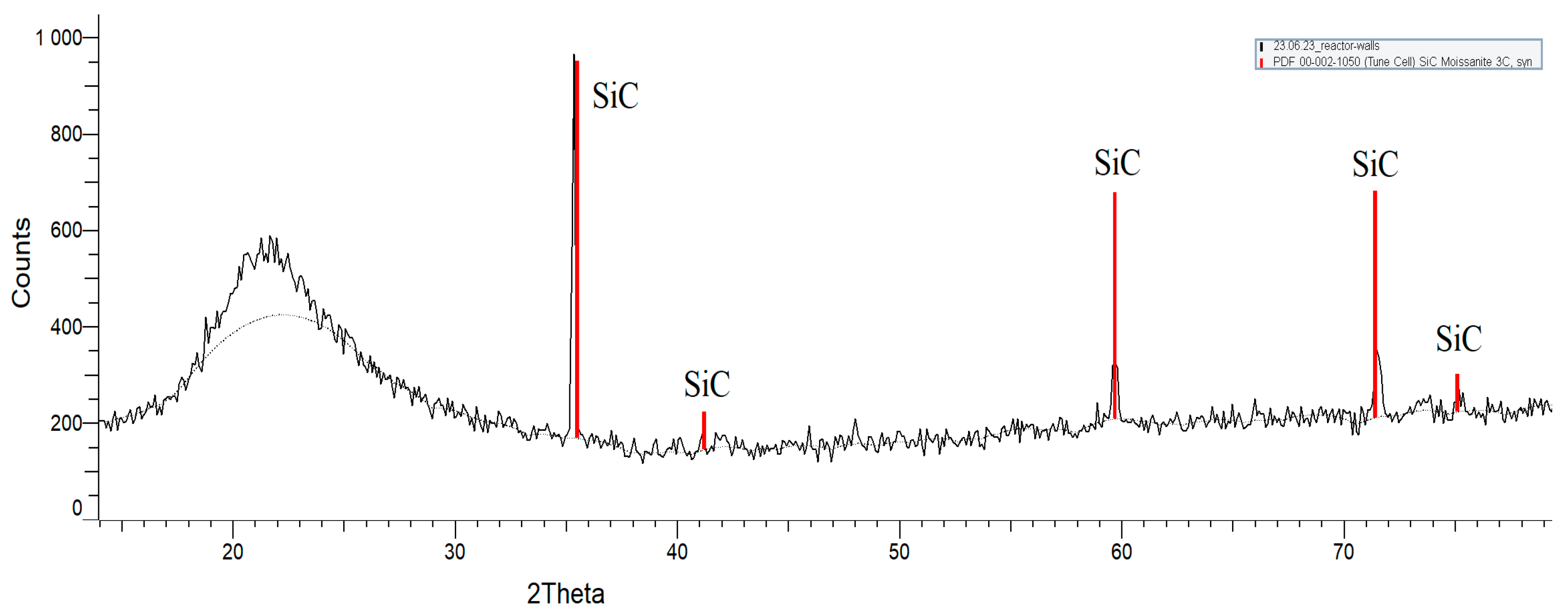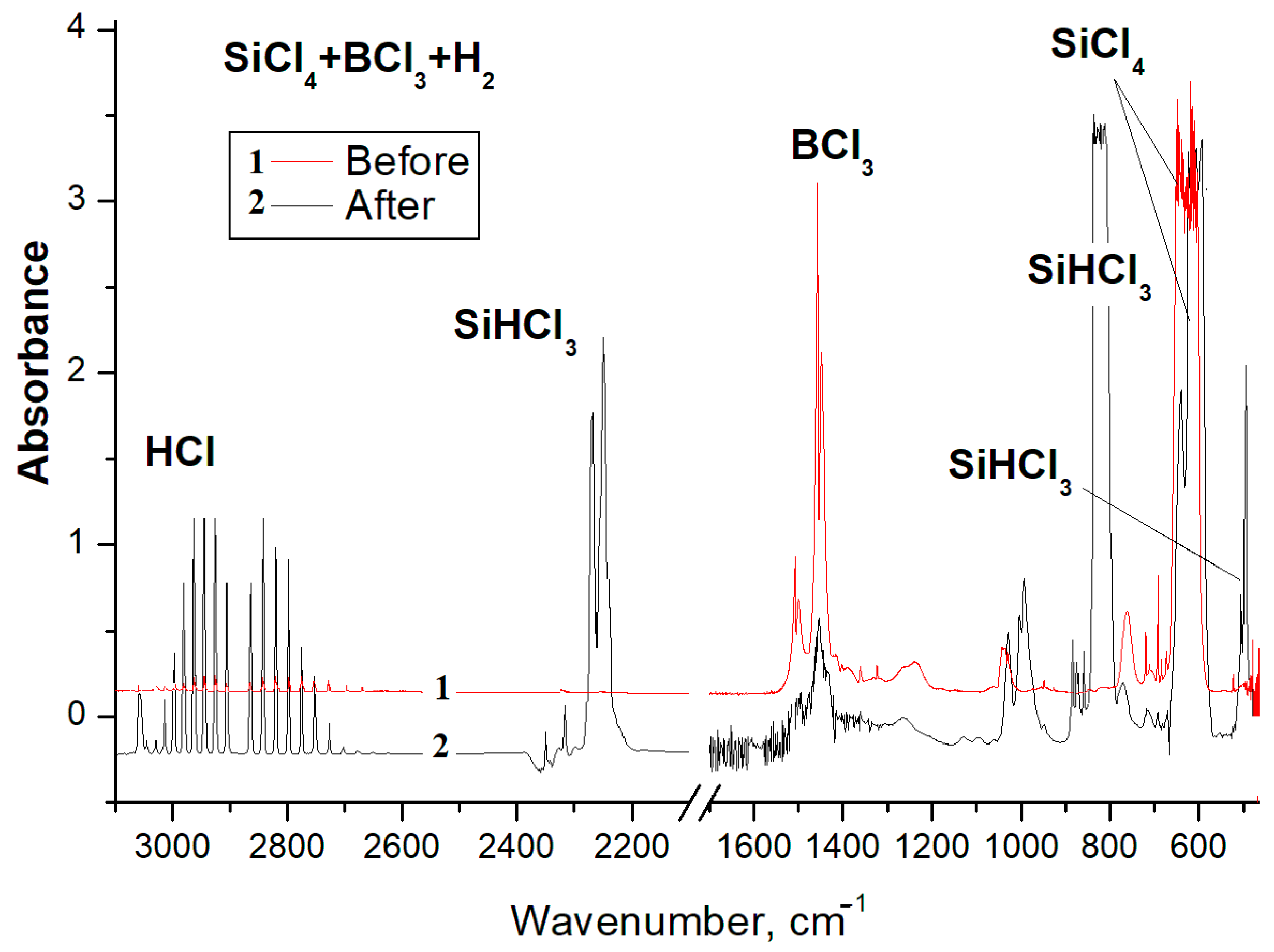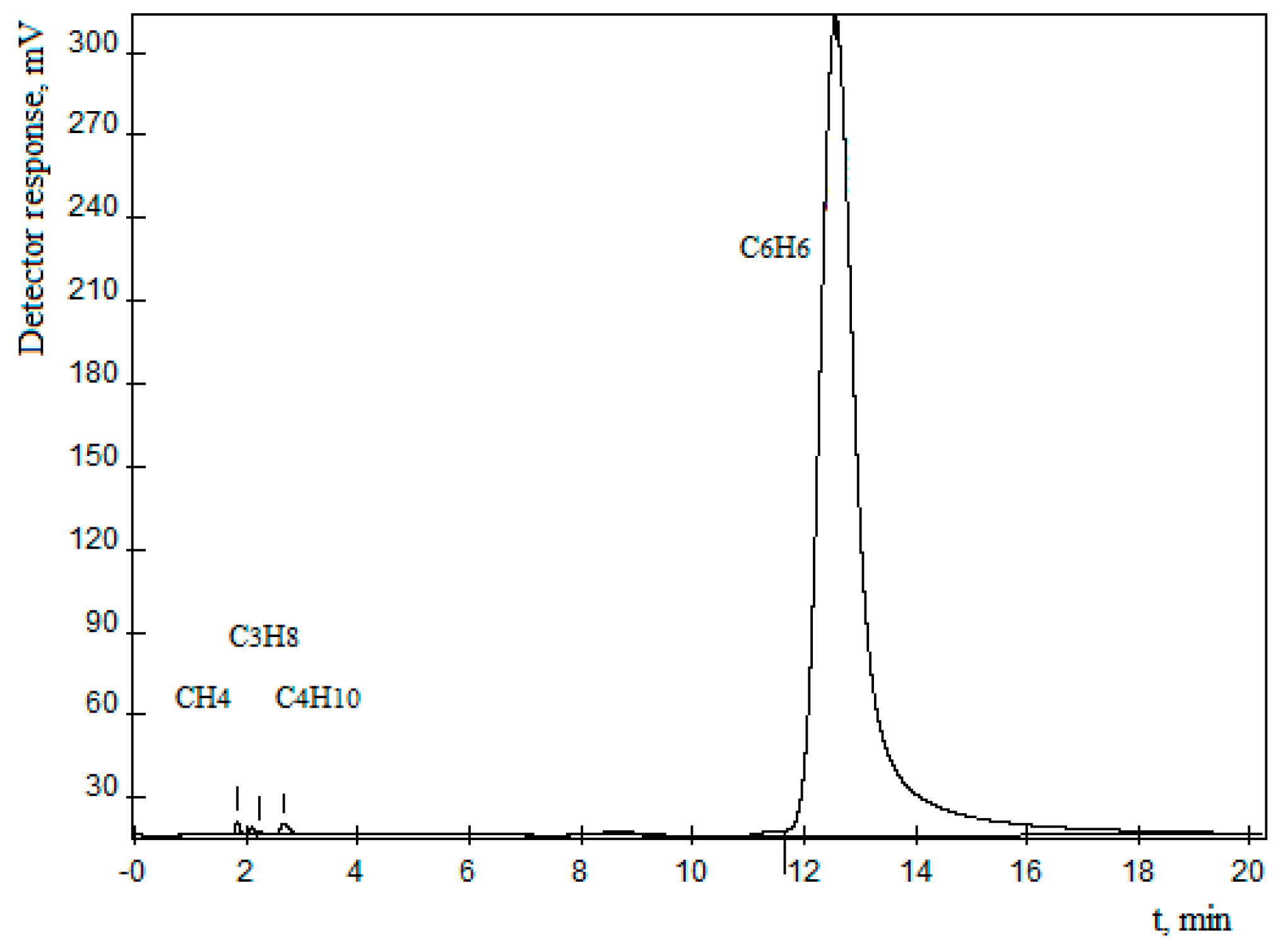Method for Removing Impurities by Treating Silicon Tetrachloride with Hydrogen Plasma
Abstract
1. Introduction
2. Results
ΔGr (1200 K) = −441.3 kJ/mol
ΔGr (1200 K) = −299.0 kJ/mol
ΔGr (1200 K) = −458.7 kJ/mol
ΔGr (1200 K) = −319.6 kJ/mol
ΔGr (1200 K) = −224.0 kJ/mol
ΔGr (1200 K) = −467.3 kJ/mol
ΔGr (1200 K) = −51.7 kJ/mol
ΔGr (1200 K) = −190.3 kJ/mol
ΔGr (1200 K) = −5.9 kJ/mol
Thermodynamic and Gas-Dynamic Analyses
ΔGr (1200 K) = −386.8 kJ/mol
ΔGr (1200 K) = −244.5 kJ/mol
ΔGr (1200 K) = −349.7 kJ/mol
ΔGr (1200 K) = −210.6 kJ/mol
ΔGr(1200 K) = −115.1 kJ/mol
ΔGr (1200 K) = −358.4 kJ/mol
ΔGr (1200 K) = 48.5 kJ/mol
3. Materials and Methods
3.1. Gas Chromatography Analysis
3.2. IR Spectroscopy of Exhaust Gases
3.3. Characterization of Solid Deposits
4. Conclusions
Author Contributions
Funding
Institutional Review Board Statement
Informed Consent Statement
Data Availability Statement
Conflicts of Interest
References
- Zhuchok, O.; Stolmakov, Y.; Mochalov, G. Thermodynamics and kinetics of the reaction of catalytic dismutation of chlorosilanes in the vapor phase in the temperature range of 353–393 K. Chem. Eng. 2023, 7, 13–27. [Google Scholar]
- Marlett, E.M.; Baton, R.L.; McKinnie, B.G. Silane Production from Magnesum Hydrde. U.S. Patent 4,725,419, 16 February 1988. C01B33/04. [Google Scholar]
- Kamarzin, A.A.; Lavrentiev, V.I.; Podoinitsins, S.V.; Bychkovv, S.I.; Mukhin, V.V.; Muratov, E.P.; Rozhkov, V.V.; Snopkov, U.V. Method for Production of Monosilane from Silicon Tetrachloride. Russia Patent 2173297C2, 10 September 2001. C01B33/04. [Google Scholar]
- Petrik, V.I.; Gryzlov, B.V. Method of Producing Monosilane. Russia Patent 2390494C1, 27 May 2006. C01B 33/04. [Google Scholar]
- Eugen, M.S.; Schwarz, R. A Process for Producing Chlorosilanes. U.S. Patent 4,217,334, 12 August 1980. C01B33/04. [Google Scholar]
- Bohmammel, K.; Keter, K.B.; Revere, S.K.; Revere, G.R.; Monkevich, I.R.; Jaroslav Monkevichhans-Jurgen Hene, J.M.-J.; Hene, H.-J. Method of Producing Trichlorosilane Through Catalytic Hydrohalogenation of Silicon Tetrachloride. Russia Patent 2371388C2, 27 October 2009. C01B33/107. [Google Scholar]
- Iya, S.K. Production of Ultra-High-Purity Polucrystalline Silicon. J. Cryst. Growth 1986, 75, 88–90. [Google Scholar] [CrossRef]
- Sarma, K.R.; Ricejr, M.J. A Method Is Disclosed for the Plasma Hydrogenation of Silicon Tetrachloride. U.S. Patent 4,309,259, 5 January 1982. C01B33/1071. [Google Scholar]
- Lepage, J.-L.; Gerard, S. Production of Trichlorosilane Used to Produce High-Purity Silicon. France Patent 2,530,638, 22 February 1984. C01B33/1071. [Google Scholar]
- Sarma, K.R.; Chanley, C.S. Process for the Hydrogenation of Silicon Tetrachloride. U.S. Patent 4,542,004, 17 September 1985. C01B33/1071. [Google Scholar]
- Gromov, G.N.; Bolgov, M.V.; Muravitskii, S.A.; Gavrilov, P.M.; Revenko, Y.A.; Levinsky, A.I.; Gushchin, V.V.; Petrusevich, F.V. A Method for Producing Trichlorosilane by Plasma Chemical Hydrogenation of Silicon Tetrachloride and a Device for Its Implementation. Russia Patent 2,350,558, 27 March 2009. C01B33/107. [Google Scholar]
- Zhenxi, L.U.; Zhang, W. Hydrogenation of Silicon Tetrachloride in MicroWave Plasma. Chin. J. Chem. Eng. 2014, 22, 227–233. [Google Scholar]
- Wu, L.; Ma, Z.; He, A.; Wang, J. Studies on destruction of silicon tetrachloride using microwave plasma jet. J. Hazard. Mat. 2010, 173, 305–309. [Google Scholar] [CrossRef] [PubMed]
- Wu, L.; Ma, Z.; He, A.; Wang, J. Decomposition of Silicon Tetrachloride by Microwave Plasma Jet at Atmospheric Pressure. Inorg. Mat. 2009, 45, 1403–1407. [Google Scholar] [CrossRef]
- Deryzemlia, A.M.; Kryshtal, P.G.; Malykhin, D.G.; Radchenko, V.I.; Shirokov, B.M. Deposition of nanocrystaline silicon films into low frequency induction RF discharge. Вoпрoсы атoмнoй науки и техники 2014, 1, 147–150. [Google Scholar]
- Kornev, R.; Gornushkin, I.; Shabarova, L.; Kadomtseva, A.; Mochalov, G.; Rekunov, N.; Romanov, S.; Medov, V.; Belousova, D.; Maleev, N. Plasma-Chemical Disposal of Silicon and Germanium Tetrachlorides Waste by Hydrogen Reduction. Sci 2023, 6, 1. [Google Scholar] [CrossRef]
- Belov, G.V.; Iorish, V.S.; Yungman, V.S. IVTANTHERMO for Windows—Database on thermodynamic properties and related software. Calphad 1999, 23, 173–180. [Google Scholar] [CrossRef]
- Gornushkin, I.B.; Sennikov, P.G.; Kornev, R.A.; Polyakov, V.S. Equilibrium calculations for plasmas of volatile halides of III, IV and VI group elements mixed with H2 and H2 + CX4 (X = H, Cl, F) relevant to PECVD of isotopic materials. J. Radioanal. Nuc. Chem. 2020, 326, 407–421. [Google Scholar] [CrossRef]
- Timofeev, P.A.; Timofeev, A.N. Thermodynamic assessment of capability for deposition of silicon borides from their halogenides. Powder Metal. Func. Coat. 2017, 1, 58–63. [Google Scholar] [CrossRef][Green Version]
- Ignaciot, E.W.; Schlegel, H.B. Ab Initio Study of the Structures, Properties, and Heats of Formation of Fluorochloromethanes and -silanes, CH4-m-nFmCIn and SiH4-m-nFmCIn (m + n = 0–4). J. Phys. Chem. 1992, 96, 5830–5837. [Google Scholar] [CrossRef]
- de Mandirola, O.B. Infra-red absorption intensities and bond moments in BCl3. Spectrochim. Acta 1967, 23A, 767–772. [Google Scholar] [CrossRef]
- Kornev, R.; Sennikov, P.; Nazarov, V.; Kut´in, A.; Plekhovich, A. Investigation of conversion process of SiCl4+СCl4 mixture by RF (40.68 MHz) Arc discharge. Plasma Phys. Technol. 2019, 6, 111–114. [Google Scholar] [CrossRef]
- Sennikov, P.G.; Kornev, R.A.; Shishkin, A.I. Preparation of Boron Carbide from BF3 and BCl3 in Hydrogen Plasma of Arc RF Discharge. Plasma Chem. Plasma Process. 2017, 37, 997–1008. [Google Scholar] [CrossRef]
- Krylov, V.A.; Chernova, O.Y. Gas chromatographic analysis of high-purity phosphorus oxychloride with microextraction concentration of impurities. J. Anal. Chem. 2020, 75, 660–665. [Google Scholar] [CrossRef]



| Impurity | [c] in the Initial SiCl4, wt.% | [c] in a Mixture (SiCl4 + SiHCl3), wt.% | α, % |
|---|---|---|---|
| CCl4 | 2.4 × 10−4 | 2.4 × 10−6 | 99 |
| HCl3 | 3.1 × 10−5 | 4.3 × 10−6 | 86 |
| C2Cl4 | 7.1 × 10−5 | 3.9 × 10−5 | 45 |
| C2HCl3 | 8.5 × 10−5 | 3 × 10−5 | 64 |
| C2H2Cl2 | 7.3 × 10−5 | 3 × 10−5 | 58 |
| C2H2Cl4 | 2.6 × 10−4 | 2 × 10−4 | 23 |
| Impurity | The Initial SiCl4, wt.% | Mixture of Chlorosilanes SiCl4+SiHCl3 After Plasma, wt.% | α, % |
|---|---|---|---|
| CH4 | ˂1.6 × 10−5 | 4.1 × 10−4 | --- |
| C3H8 | 1.5 × 10−5 | 2.2 × 10−5 | --- |
| C4H10 | 1 × 10−5 | ˂5 × 10−6 | 50 |
| C6H6 | 0.075 | 0.0070 | 91 |
Disclaimer/Publisher’s Note: The statements, opinions and data contained in all publications are solely those of the individual author(s) and contributor(s) and not of MDPI and/or the editor(s). MDPI and/or the editor(s) disclaim responsibility for any injury to people or property resulting from any ideas, methods, instructions or products referred to in the content. |
© 2025 by the authors. Licensee MDPI, Basel, Switzerland. This article is an open access article distributed under the terms and conditions of the Creative Commons Attribution (CC BY) license (https://creativecommons.org/licenses/by/4.0/).
Share and Cite
Kornev, R.; Mochalov, G.; Maleev, N.; Romanov, S.; Kornev, K.; Kalinina, A. Method for Removing Impurities by Treating Silicon Tetrachloride with Hydrogen Plasma. Inorganics 2025, 13, 80. https://doi.org/10.3390/inorganics13030080
Kornev R, Mochalov G, Maleev N, Romanov S, Kornev K, Kalinina A. Method for Removing Impurities by Treating Silicon Tetrachloride with Hydrogen Plasma. Inorganics. 2025; 13(3):80. https://doi.org/10.3390/inorganics13030080
Chicago/Turabian StyleKornev, Roman, Georgy Mochalov, Nikita Maleev, Sergei Romanov, Konstantin Kornev, and Alexandra Kalinina. 2025. "Method for Removing Impurities by Treating Silicon Tetrachloride with Hydrogen Plasma" Inorganics 13, no. 3: 80. https://doi.org/10.3390/inorganics13030080
APA StyleKornev, R., Mochalov, G., Maleev, N., Romanov, S., Kornev, K., & Kalinina, A. (2025). Method for Removing Impurities by Treating Silicon Tetrachloride with Hydrogen Plasma. Inorganics, 13(3), 80. https://doi.org/10.3390/inorganics13030080






